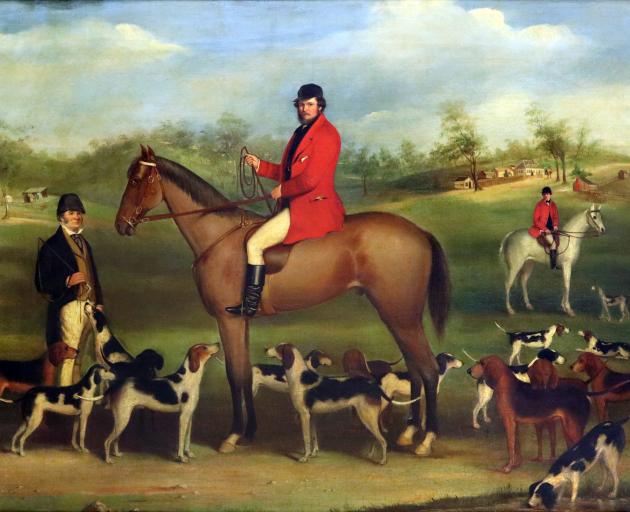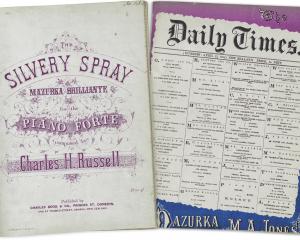
In 1923 a local newspaper reported that the collections of the Otago Early Settlers’ Association had been "enriched by the gift from Mr J.S. Kirkpatrick of a portrait in oils of Mr George Dodson as a huntsman". The painting had belonged to Mr Kirkpatrick’s late wife, Jane, who was a daughter of George and Mary Ann Dodson.
Convinced there was a good story lurking behind such a fantastic painting, I set about hunting the huntsman whose likeness is recorded on its canvas.
George and Mary Ann Dodson were from Yorkshire in England, where they married about 1848. A son, Thomas, and a daughter, Alice, were born there, but Jane was born in Victoria, Australia. George came to Otago in the early 1860s, with Mary Ann, Tom, Alice, and Jane likely only joining him after travelling out on the William Davie from Glasgow in 1870.
George became a publican in Otago. He was particularly well-known as the proprietor of the Port Chalmers Hotel and owner of the Empire Hotel in Dunedin, which was run by his son Tom. George also engaged in provisioning ships and built a bond store at the port.
He became involved in local affairs in the town, serving as a Port Chalmers borough councillor in the 1860s and 1870s.
As president of the Port Chalmers Cricket Club, he played a role in hosting the All England Eleven when they visited in 1864. Port Chalmers was suitably decorated for the occasion and a large tent was erected at Dodson’s hotel to accommodate 200 diners at a welcome luncheon. However, the festivities were marred by inclement weather and guests arrived at the hotel to find that the tent was gone, toppled like a house of cards by high winds. The luncheon tables had already been laid out when the disaster occurred. The salvaged feast was hastily moved indoors, the hotel’s billiard table acting as a buffet.
When a Yorkshire Club was formed in Dunedin in 1876 the Dodsons were again involved, hosting the club’s inaugural picnic and ball at their farm and in the bond store. Between 200 and 300 revellers are said to have assembled in the bond store and danced vigorously until the small hours.
George Dodson loved all sports but had a particular passion for horses, as evidenced by the painting.
The painting likely shows Dodson running a pack of hounds in Sandhurst, Australia where he was fondly remembered for organising such hunts. Following his death in December 1882 the Otago Witness newspaper recalled "years ago ... there lived somewhere in the vicinity of Sandhurst a fine, hearty, good-looking Yorkshireman named George Dodson, a thorough sportsman, like all Yorkshiremen are. There he hunted a small pack of hounds, enjoyed a bit of sport in his own quiet way, and was a favourite with everybody."
The article goes on to describe Dodson as "one of the leading lights of the sporting world" in Dunedin too, especially in relation to horse racing. He was an early member of the Dunedin Jockey Club and acted as a starter at race meetings for many years.
In the 1870s he began breeding horses at his Sawyers Bay farm, hoping to produce many top-quality racehorses from Cassivelaunus, a stallion that was a progeny of 1862 Derby winner Caractacus.
However, Cassivelaunus did not live up to expectations and notable wins on the track by his offspring were few.
Mary Ann Dodson died in May 1882 and George in December that year. The farm and bloodstock passed to Tom.
Like his father, Thomas Hirst Dodson was a publican, acted as a starter for the Jockey Club and was involved in local politics. He served as Mayor of Port Chalmers in 1883-4.
In 1884, however, Tom Dodson was adjudged bankrupt. Dodson’s farm and its stock were sold.
Cassivelaunus died the following year. The days of Dodson’s stud farm and its star stallion were over.



![‘‘Neil’s Dandelion Coffee’’. [1910s-1930s?]. EPH-0179-HD-A/167, EPHEMERA COLLECTION, HOCKEN...](https://www.odt.co.nz/sites/default/files/styles/odt_landscape_small_related_stories/public/slideshow/node-3436487/2025/09/neils_dandelion_coffee.jpg?itok=fL42xLQ3)







